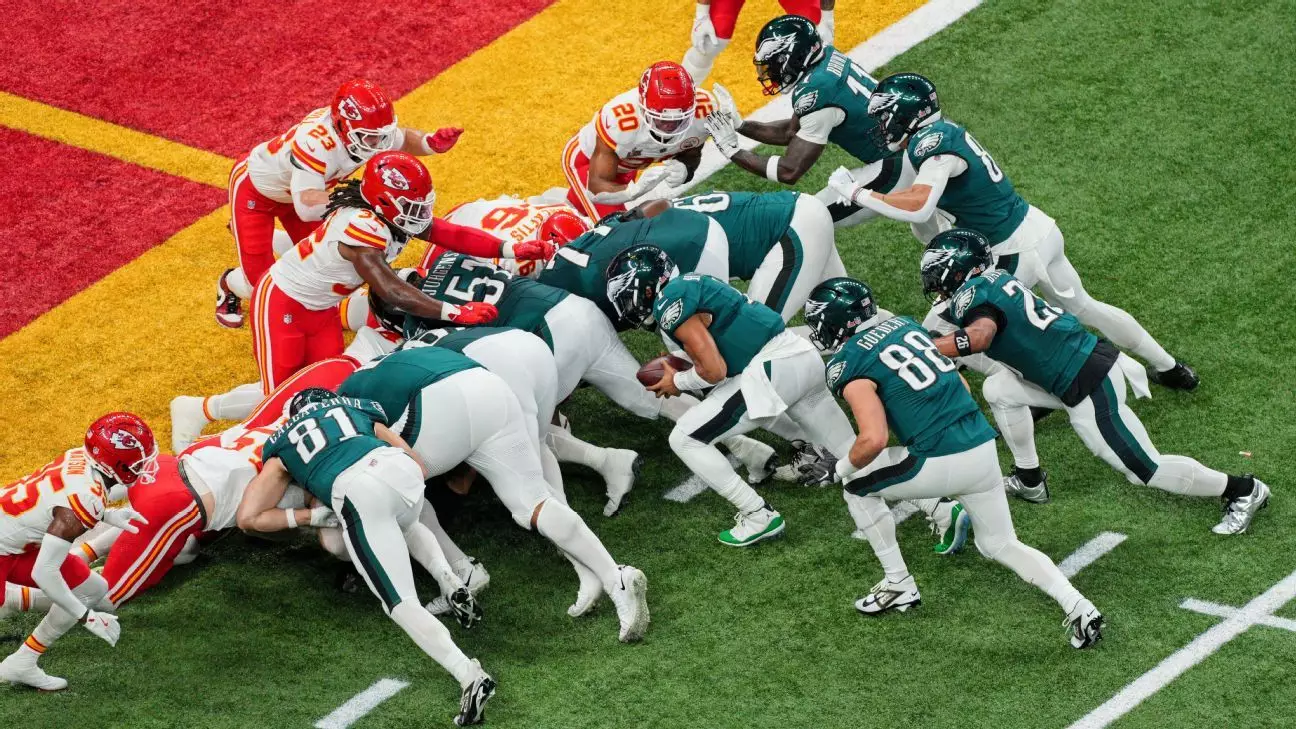The National Football League (NFL) is a landscape rife with strategies and innovations, yet some tactical choices spark intense debates among teams, owners, and fans alike. One such play that has emerged as a focal point of contention is the “tush push,” a quarterback sneak that has gained notoriety for its effectiveness. Recently, a team has put forth a proposal to ban this controversial maneuver, reigniting discussions on safety, fairness, and the evolving nature of football.
Troy Vincent, the NFL’s Executive Vice President of Football Operations, announced during the scouting combine that one unidentified team has suggested prohibiting the tush push. The proposal is officially labeled as a “club playing-rule proposal” and is slated for discussion among team owners next month in Palm Beach, Florida. Should it advance to a vote, a substantial majority—specifically, 24 out of 32 owners—would need to endorse the ban for it to pass. As noted by Vincent, the thrust of the argument centers around the potential need for adjustments to the play and whether it represents a legitimate tactic in modern football.
This inquiry into the legitimacy of the tush push encapsulates a broader question facing the NFL. Should the league adapt its rules to keep pace with innovative strategies, or should it curb those tactics that appear to give certain teams an overwhelming advantage? These inquiries are pivotal, especially as the league aims to maintain a level playing field while ensuring the safety of its players.
The statistics surrounding the tush push are undeniably compelling. Over the past three seasons, the Philadelphia Eagles and Buffalo Bills have executed 163 tush pushes, achieving an impressive 87% success rate in scoring touchdowns or obtaining first downs. This efficiency starkly contrasts with the league’s overall success rate, which stands at 71%. Highlighting the disparity, the Eagles’ quarterback sneak, often called the “Brotherly Shove,” gained prominence when it was instrumental in the Eagles’ touchdown during Super Bowl LIX.
The relationship between execution and success creates a dichotomy within the league: while the Eagles and Bills have seemingly perfected the play, other teams struggle to replicate their results. This reality strikes at the heart of the proposal—should a tactic that has proven fruitful for certain teams be eliminated for the sake of parity?
Surprisingly, the NFL has wrestled with the tush push in the past; discussions have occurred in previous offseasons without any decisive action. Vincent mentioned that prior conversations also included parallel concerns surrounding new tackle techniques like the “hip drop.” The historical context suggests that the league has been cautious, recognizing that while certain plays are effective, they often lead to increased physicality on the field, raising safety concerns.
Fans have already witnessed controversial moments in high-stakes games, such as Washington Commanders linebacker Frankie Luvu’s penalties when attempting to halt the Eagles’ play during the NFC Championship Game. Such incidents demonstrate the thin line that resides between tactical ingenuity and potential safety risks, further complicating the discussion surrounding this so-called “unfair” advantage.
Eagles coach Nick Sirianni has been an outspoken advocate for maintaining the current interpretation of the rule governing the tush push. His position signifies a deep-rooted sentiment among coaches whose teams show particular proficiency in specialized plays. Sirianni’s comments underscore the idea that any potential rule change should not penalize teams for capitalizing on tactical success that is, at least in their perspective, a legitimate football strategy.
The insistence on preserving the tush push shines a light on the emotional weight of such proposals. Contextually, any potential ban could ripple into the core of team identity, affecting not just how games are played, but how they are coached and strategized.
The debate over the tush push encompasses much more than just a single play; it symbolizes the ongoing evolution of the NFL as it navigates the complex interplay between tradition and innovation, player safety and competitive edge. As the league progresses towards a vote on the future of this controversial maneuver, all eyes will be on how this decision reflects the broader values of the NFL today. Ultimately, whether to ban the tush push could set a significant precedent in how football is played, watched, and understood in a rapidly changing sporting landscape.


Leave a Reply